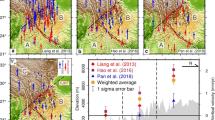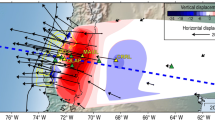Abstract
From Global Position System (GPS) measurements, there is a clockwise rotation around the eastern Himalayan syntax in the Tibetan Plateau. This phenomenon is difficult to be interpreted by simple two-dimensional modeling from a geodynamic point of view. Because of the extremely thick crust and the lower crust with relatively high temperature in the Tibetan Plateau, the lithospheric rheology in Tibet and surrounding areas present a complex structure. In general, the tectonic structure of the Tibetan Plateau consists of brittle upper crust, ductile lower crust, high viscosity lithospheric upper mantle, and low viscosity asthenosphere, the same as the case in many other continental regions. However, the lower crust in the Tibetan Plateau is much more ductile with a lower viscosity than those of its surroundings at the same depth, and the effective viscosity is low along the collision fault zone. In this study, we construct a three-dimensional Maxwell visco-elastic model in spherical coordinate system, and simulate the deformation process of the Tibetan Plateau driven by a continuous push from the Indian plate. The results show that the existence of the soft lower crust under the plateau makes the entire plateau uplift as a whole, and the Himalayas and the eastern Himalayan syntax uplift faster. Since the lower crust of surrounding blocks is harder except in the southeastern corner where the high-temperature material is much softer and forms an exit channel for material transfer, after the whole plateau reaches a certain height, the lower crustal and upper mantle material begins to move eastward or southeastward and drag the upper crust to behave same way. Thus, from the macroscopic point of view, a relative rigid motion of the plateau with a clockwise rotation around the eastern Himalayan syntax is developed.
Similar content being viewed by others
References
Tapponnier P, Peltzer G, Dain A Y L, et al. Propagating extrusion tectonics in Asia: New insights from simple experiments with plasticine. Geology, 1982, 10(12): 611–615
England P, Houseman G. Finite strain calculations of continental deformation 2. Comparison with the India-Asia collision zone. J Geophys Res, 1986, 91(3): 3664–3676
Zhang P Z, Shen Z K, Wang M, et al. Continuous deformation of the Tibetan Plateau from global positioning system data. Geology, 2004, 32(9): 809–812
Zhong D L, Ding L. Rising process of the Qinghai-Xizang (Tibet) Plateau and its mechanism. Sci China Ser D-Earth Sci, 1996, 39(4): 369–379
Shen Z K, Lv J N, Wang M, et al. Contemporary crustal deformation around the southeast borderland of the Tibetan Plateau. J Geophys Res, 2005, 110(11): B11409, doi: 10.1029/2004JB003421
Wang Q, Zhang P Z, Freymueller J T, et al. Present-day crustal deformation in China constrained by global positioning system measurements. Science, 2001, 294(10): 574–577
Royden L H, Burchfiel B C, King R W, et al. Surface deformation and lower crustal flow in eastern Tibet. Science, 1997, 276(2): 788–790
Shen F, Royden L H, Burchfiel B C. Large-scale crustal deformation of the Tibetan Plateau. J Geophys Res, 2001, 106(4): 6793–6816
Wang H, Zhang G, Shi Y, et al. Numerical simulation of movement and deformation of Qinghai-Tibet Plateau (in Chinese). J Geod Geodyn, 2006, 26(2): 15–23
Zhu S B, Shi Y L. Genetic algorithm-finite element inversion of drag forces produced by the lower crust flow to the upper crust in Sichuan-Yunnan area. Chin J Geophys, 2004, 47(2): 258–267
Liu M, Yang Y. Extensional collapse of the Tibetan Plateau: Results of three-dimensional finite element modeling. J Geophys Res, 2003, 108(8): 2361, doi: 10.1029/2002JB002248
Fu R S, Li L G, Huang J H, et al. Three-step model of the Qinghai-Xizang Plateau uplift (in Chinese). Chin J Geophys, 1999, 42(5): 609–616
Fu R S, Huang J H, Li L G, et al. Numerical simulation of the three step uplift model of the Tibetan Plateau (in Chinese). Earth Sci Front, 2000, 7(4): 588–596
Fu R S, Huang J H, Xu Y M, et al. Numerical simulation of the collision between Indian and Eurasian plates and the deformations of present Chinese continent (in Chinese). Acta Seismol Sin, 2000, 13(1): 1–7
Fu R S, Xu Y M, Huang J H, et al. Numerical simulation of the Qinghai-Xizang Plateau uplift under the effect of denudation and mantle convection (in Chinese). Chin J Geophys, 2000, 43(3): 346–355
Li Z N, Fu R S, Huang J H. Numerical simulation of the uplift process of the Qinghai-Xizang Plateau under the effect of denudation and mantle convection. Chin J Geophys, 2002, 45(4): 537–545
Zheng Y, Fu R S, Huang J H. Simulation of lithospheric evolution of the China mainland and its surrounding regions. Chin J Geophys, 2006, 49(2): 356–371
Zheng Y, Chen Y, Fu R S, et al. Simulation of the effect of faults movement on stress and deformation fields of Tibetan Plateau by discontinuous movement models. Chin J Geophys, 2007, 20(5): 1199–1212
Wang J, Ye Z R, He J K. Three-dimensional mechanical modeling of large-scale crustal deformation in China constrained by the GPS velocity field. Tectonophysics, 2008, 446: 51–60
Ding L, Zhong D L. Metamorphic characteristics and geotectonic implications of the high-pressure granulites from Namjagbarwa, eastern Tibet. Sci China Ser D-Earth Sci, 1999, 42(5): 491–505
An Z S, Kutzbach J E, Prell W L, et al. Evolution of Asian monsoons and phased uplift of the Himalaya-Tibetan Plateau since Late Miocene times. Nature, 2001, 411(6833): 62–66
Wu Y Q, Cui Z J, Liu G N, et al. Quaternary geomorphological evolution of the Kunlun Pass area and uplift of the Qinghai-Xizang (Tibet) Plateau. Geomorphology, 2001, 36(3–4): 203–216
Zhang J J, Ji J Q, Zhong D L, et al. Structural pattern of eastern Himalayan syntaxis in Namjagbarwa and its formation process. Sci China Ser D-Earth Sci, 2004, 47(2): 138–150
Pan B T, Gao H S, Li B Y, et al. Step-like landforms and uplift of the Qinghai-Xizang Plateau (in Chinese). Quat Sci, 2004, 24(1): 50–58
Zhang Q S, Zhou Y F, Lu X S, et al. On the present uplift speed of Qing-Zang Plateau. Chin Sci Bull, 1991, 36(21): 1820–1824
Kearey P, Vine F J. Global Tectonics. Oxford: Blackwell Publishing Limited, 1996. 30–33
Braitenberg C, Wang Y, Fang J, et al. Spatial variations of Flexure Parameters over the Qinghai-Tibet Plateau. Earth Planet Sci Lett, 2003, 205(3–4): 211–224
Wang Y. Heat flow pattern and lateral variations of lithoshpere strength in China mainland: Constraints on acitve deformation. Phys Earth Planet In, 2001, 126: 121–146
Shi Y L, Zhu S B. Contrast of rheology of crust and mantle near Moho revealed by depth variation of earthquake mechanism in continental China. Chin J Geophys, 2003, 46(3): 516–525
Shi Y L, Zhu Y Q. Some thermotectonic aspects of the Tibetan Plateau. Tectonophysics, 1993, 219: 223–233
Hilley G E, Bürgmann R, Zhang P Z, et al. Bayesian inference of plastosphere viscosities near the Kunlun Fault, northern Tibet. Geophys Res Lett, 2005, 32: L01302, doi: 10.1029/2004GL021658
Hu S, He L, Wang J. Heat flow in the continental area of China: A new data set. Earth Planet Sci Lett, 2000, 179(2): 407–419
Hu S B, He L J, Wang J Y. Compilation of heat flow data in the China continental area (3rd edition) (in Chinese). Chin J Geophy, 2001, 44(5): 611–626
Zhao W L, Morgan W J. Injection of Indian crust into Tibetan lower crust: A two dimensional finite element model study. Tectonics, 1987, 6(4): 489–504
Royden L. Coupling and decoupling of crust and mantle in convergent orogens: Implications for strain partitioning in the crust. J Geophys Res, 1996, 101(8): 17679–17705
Flesch L M, Haines A J, Holt W E. Dynamics of the India-Eurasia collision zone. J Geophys Res, 2001, 106(8): 16435–16460
Gao S, Luo T C, Zhang B R, et al. Structure and composition of the continental crust in East China. Sci China Ser D-Earth Sci, 1999, 42(2): 129–140
An M J, Shi Y L. Three-dimensional thermal structure of the Chinese continental crust and upper mantle. Sci China Ser D-Earth Sci, 2007, 50(10): 1441–1451
Shi Y L, Cao J L. Lithosphere effective viscosity of continental China. Earth Sci Front, 2008, 15(3): 82–95
Zhang Z J, Teng J W, Li Y K, et al. Crustal structure of seismic velocity in southern Tibet and east-westward escape of the crustal material-An example by wide-angle seismic profile from Peigu Tso to Pumoyong Tso. Sci China Ser D-Earth Sci, 2004, 47(6): 500–506
Zhu S B, Shi Y L. Origin of tectonic stresses in the Chinese continent and adjacent areas. Sci China Ser D-Earth Sci, 2006, 50(1): 67–74
Wang H, Cao J L, Zhang H, et al. Numerical simulation of the influence of lower-crustal flow on the deformation of the Sichuan-Yunnan region. Acta Seismol Sin, 2007, 20: 617–627
An M J, Shi Y L. Lithospheric thickness of the Chinese continent. Phys Earth Planet Int, 2006, 159(3–4): 257–266
Tong W, Mu Z G, Liu S B. The Late-Cenozoic volcanoes and active high-temperature hydrothermal systems in China (in Chinese). Chin J Geophys, 1990, 33(3): 329–335
Jiang C S. Distribution characteristics of Tengchong volcano in the Cenozoic era (in Chinese). J Seismol Res, 1998, 21(4): 309–319
Deng W M. Cenozoic volcanic activity and its geotectonic background in west China—Formative excitation mechanism of volcanic rocks in Qinghai-Xizang and adjacent districts (in Chinese). Earth Sci Front, 2003, 10(2): 471–478
Flesch L M, Holt W E, Silver P G, et al. Constraining the extent of crust-mantle coupling in central Asia using GPS, geologic, and shear wave splitting data. Earth Planet Sci Lett, 2005, 238: 248–268
Hirn A, Jiang M, Sapin M, et al. Seismic anisotropy as an indicator of mantle flow beneath the Himalayas and Tibet. Nature, 1995, 375(6532): 571–574
Sandvol E, Ni J, Kind R, et al. Seismic anisotropy beneath the southern Himalayas-Tibet collision zone. J Geophys Res, 1997, 102(B8): 17813–17824
Lev E, Long M D, Hilst R D. Seismic anisotropy in Eastern Tibet from shear wave splitting reveals changes in lithospheric deformation. Earth Planet Sci Lett, 2006, 251: 293–304
Huang W C, Ni J F, Tilmann F, et al. Seismic polarization anisotropy beneath the central Tibetan Plateau. J Geophys Res, 2000, 105(B12): 27979–27990
McNamara D E, Owens T J, Silver P G, et al. Shear wave anisotropy beneath the Tibetan Plateau. J Geophys Res, 1994, 99(B7): 13655–13666
Cui X F, Xie F R, Zhang H Y. Recent tectonic stress field zoning in Sichuan-Yunnan region and its dynamic interest (in Chinese). Acta Seismol Sin, 2006, 28(5): 451–461
Author information
Authors and Affiliations
Corresponding author
Additional information
Supported by Knowledge Innovation Project of the Chinese Academy of Sciences (Grant No. KZCX2-YW-123) and National Natural Science Foundation of China (Grant Nos. 40774048 and 90814014)
About this article
Cite this article
Cao, J., Shi, Y., Zhang, H. et al. Numerical simulation of GPS observed clockwise rotation around the eastern Himalayan syntax in the Tibetan Plateau. Chin. Sci. Bull. 54, 1398–1410 (2009). https://doi.org/10.1007/s11434-008-0588-7
Received:
Accepted:
Published:
Issue Date:
DOI: https://doi.org/10.1007/s11434-008-0588-7




